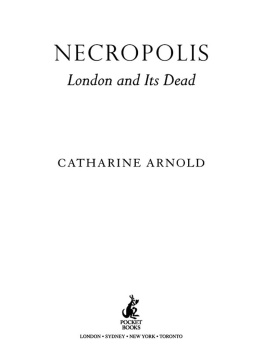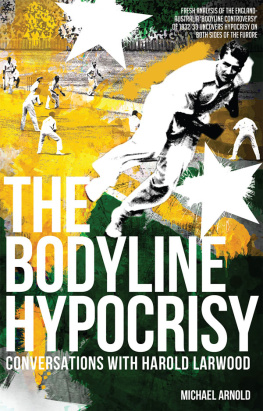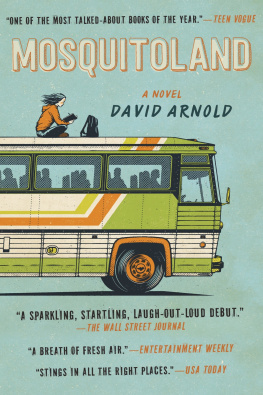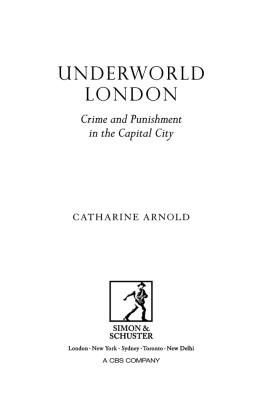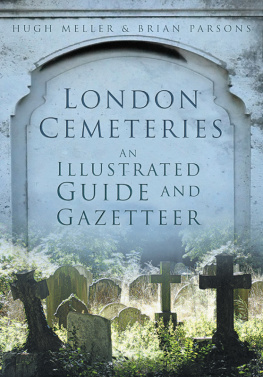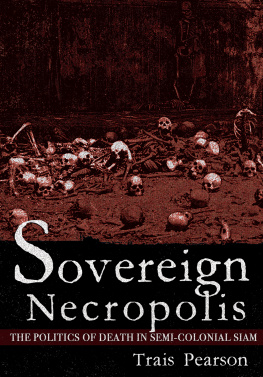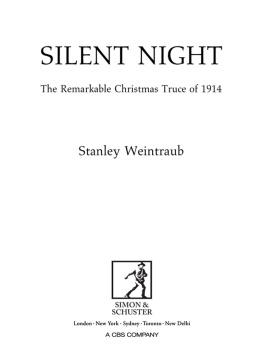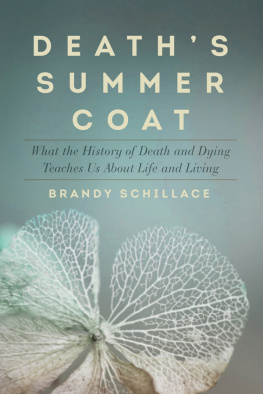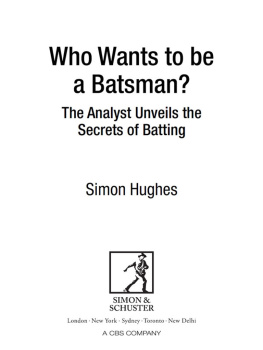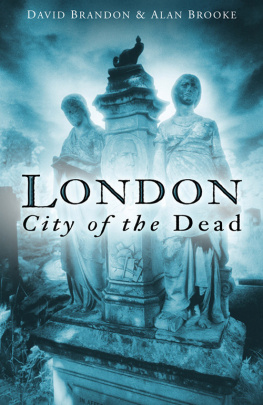CATHARINE ARNOLD read English at Cambridge and holds a further degree in psychology. A journalist and academic with a particular interest in death and crime, Catharines previous books include the acclaimed novel Lost Time.
Further praise for Necropolis:
An elegant saunter through the land of the dead
Jad Adams, Guardian
Catharine Arnold conjures up an appalling vista of endless grinning skulls stretching back into prehistory... [It] works as a handy one-stop-shop for all things morbid from the fate of Cromwells skull to the Necropolis Railway, post-mortem photography and beyond... The big set-piece with which Arnold ends her story is, of course, the overwrought funeral of Diana, Princess of Wales. Though by the time we get there, it starts to look less like a bizarre aberration and more a natural extension of all the eccentric, moving and ingenious ways Londoners have faced down the spectre of death
Suzi Feay, Independent on Sunday
There has always been a certain relish in recounting the decay of flesh... That is why Necropolis is deeply pleasing: it satisfies the desire for wayward knowledge, being a compendium of death in all its forms... If you wish to go on a pilgrimage down these gravel paths and among these white sepulchres, this book should be your guide
Peter Ackroyd, The Times
Much of Catharine Arnolds account of Londons relationship with its dead carries [a] guiltily pleasurable charge of macabre interest... Where Arnolds account really beguiles is in its eccentric social detail, from the various mourning fashions in the late Victorian age to the medical consultant Francis Seymour Hadens enthusiasm for wickerwork caskets
Sinclair McKay, Daily Telegraph
Stitching archaeological discovery and architectural detail to anecdote and cultural commentary, Necropolis paints London as a city drained by death... This book offers a fascinating ramble through the cadavers of Londons history, with the irresistible draw of finding out more about what lies under our pavements
Anna Metcalfe, Financial Times

First published in Great Britain by Simon & Schuster UK Ltd, 2006
This edition first published by Pocket Books, 2007
An imprint of Simon & Schuster UK Ltd
A CBS COMPANY
Copyright 2006 by Catharine Arnold
This book is copyright under the Berne Convention.
No reproduction without permission.
All rights reserved.
The right of Catharine Arnold to be identified as author of this work has been asserted in accordance with sections 77 and 78 of the Copyright, Designs and Patents Act, 1988.
Simon & Schuster UK Ltd
Africa House
6478 Kingsway
London WC2B 6AH
www.simonsays.co.uk
Simon & Schuster Australia
Sydney
A CIP catalogue record for this book is available from the British Library.
ISBN-13: 978-1-4165-0248-7
eISBN: 978-1-8473-9493-4
Typeset in Granjon by M Rules
Printed and bound in Great Britain by Cox & Wyman Ltd, Reading, Berks
Picture credits
The Art Archive:
Corbis Images:
The Highgate Literary and Scientific Institution:
The Museum of London:
The Illustrated London News:
The Victoria and Albert Museum:
For my parents
In Memoriam

NECROPOLIS
Acknowledgements
Many people have helped me in the creation of this book, taking time and trouble to give me their advice and sources for further reference. I would like to take this opportunity to thank the following: Jean Pateman and the Friends of Highgate Cemetery; Ron Woollacott and the Friends of Nunhead Cemetery; Robert Stephenson and the Friends of Brompton Cemetery; Roger Arber of The Cremation Society of Great Britain; Henry Vivian-Neal and the Friends of Kensal Green Cemetery; Stephen White; John M. Clarke; Brookwood Cemetery Society; the Reverend Dr Peter Jupp; Andrew Gordon and Edwina Barstow at Simon & Schuster; Joan Deitch; Dr Sarah Niblock; Simon Cadman; Sarah Crichton and Guy Martin of Brooklyn, New York, for assisting with my American research; the British Library; the University Library, Cambridge; the Hallward Library, University of Nottingham; the Museum of London; the Victoria and Albert Museum; Vanessa Dale; my agent, Charlie Viney; and last but not least, my family, particularly my husband, whose constant encouragement and support sustained me throughout writing Necropolis.
Introduction
When Sir Christopher Wren was commissioned to rebuild St Pauls Cathedral after it had been destroyed by the Great Fire of London in 1666, he made an astonishing discovery. As Mrs Isabella Holmes reveals in her marvellous book of 1898, The London Burial Grounds:
Upon digging the foundation of the present fabrick of St Pauls, he found under the graves of the latter ages, in a row below them, the Burial-places of the Saxon times the Saxons, as it appeared, were accustomed to line their graves with chalkstones, though some more eminent were entombed in coffins of whole stones. Below these were British graves, where were found ivory and wooden pins of a hard wood, seemingly box, in abundance, of about six inches long; it seems the bodies were only wrapped up, and pinned in wooden shrouds, which being consumed, the pins remained entire. In the same row, and deeper, were Roman urns intermixed. This was eighteen feet deep or more, and belonged to the colony, where Romans and Britons lived and died together.
Wrens discovery reminds us that London is one giant grave. So many generations have lived and died here within such a small span pagan, Roman, mediaeval, Victorian and left intriguing traces of their lives: like the skulls of Romans, murdered by Boudicca, recovered from the Thames, and the clay pipes of plague victims, discovered during excavations for the Piccadilly Line. In fact, the tunnel curves between Knightsbridge and South Kensington stations because it was impossible to drill through the mass of skeletal remains buried in Hyde Park. London, from six feet under, is not just Cobbetts Great Wen, it is the city a horrified young Thomas Carlyle dubbed the Great Maw!
Death provides a fascinating mirror through which to view London, as it has grown and changed. This book does not claim to be an exhaustive survey of every burial ground; for that, we must turn to Isabella Holmes, who chronicled every cemetery in London, and to Hugh Mellers excellent Gazeteer. The intention is to examine how London has coped with its dead from the pagan era to the present day, and the men and women who have played a part, from the mysterious Roman lady of Spitalfields to Graham Greene and his experience of the Blitz; from the cortge of Queen Elizabeth I to the funeral of Diana, Princess of Wales, 400 years later; and from the Dickensian horrors of the overcrowded inner-city churchyards to the Victorian Valhallas of Kensal Green, Highgate and Brompton.
My own interest in graveyards began in childhood, when I used to walk home from school through Nottinghams Rock Cemetery, with its magnificent marble angels and sandstone catacombs. When I moved to London, and longed for green tranquil spaces, I spent weekends exploring the great Victorian burial grounds. The word cemetery derives from the Greek
Next page
